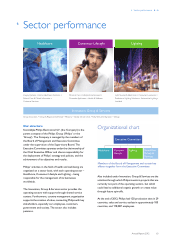Philips 2012 Annual Report Download - page 55
Download and view the complete annual report
Please find page 55 of the 2012 Philips annual report below. You can navigate through the pages in the report by either clicking on the pages listed below, or by using the keyword search tool below to find specific information within the annual report.
5 Group performance 5.2.10 - 5.2.11
Annual Report 2012 55
were continued-conformance audits, because the
majority of our risk suppliers had already undergone an
audit in the past.
Accumulative number of initial and continual
conformance audits
2,000
1,500
1,000
500
0
150
2005
365
2006
166
2007
277
2008
360
2009
273
2010
212
2011
159
2012
1,962
total
Distribution of supplier audits by country
China
110
India
21
Brazil
11
Other
17
Audit findings
We believe it is important to be transparent about the
issues we observe during the audits. Therefore we have
published a detailed list of identified major non-
compliances in our Annual Report since 2010. To track
improvements, Philips measures the ‘compliance rate’ for
the identified risk suppliers, i.e. the percentage of risk
suppliers that were recently audited and had resolved all
major non-compliances. During 2012 we achieved a
compliance rate of 75% (2011: 72%).
Please refer to section 14.5, Supplier indicators, of this
Annual Report for the detailed findings of 2012.
Supplier development and capacity building
Based on many years of experience with the audit
program, we know that a combination of audits, capacity
building, consequence management and continuous
attention from management is crucial to realize structural
and lasting changes at supplier production sites. During
2012 we extended our capacity-building initiatives, which
are offered to help suppliers improve their practices. Our
supplier sustainability experts in China, India and Brazil
organized classroom trainings, regularly visited suppliers
for on-site consultancy on specific topics, and helped
suppliers to train their own workers on topics like
occupational health and safety.
We also teamed up with industry peers, non-
governmental organizations and a trade union to work on
capacity building at Chinese factories via
the IDH Electronics Program. This program was kicked
off in 2011 and is an innovative multi-stakeholder initiative
sponsored by the Sustainable Trade Initiative (IDH)
together with Dell, HP, Philips and civil society
organizations. The goal is to improve working conditions
for more than 500,000 employees in the electronics
sector. In 2012 we continued the implementation phase
in China’s Pearl River Delta and a total of eight Philips
suppliers are now involved in the program.
5.2.11 Conflict minerals: issues further down the
chain
Philips is concerned about the situation in the east of the
Democratic Republic of the Congo (DRC) where
proceeds from the extractives sector are used to finance
rebel conflicts in the region. Philips is committed to
address this issue through the means and influencing
mechanisms available to us, even though we do not
directly source minerals from the DRC and mines are
typically seven or more tiers removed from our direct
suppliers.
During 2012 we worked with 347 priority suppliers to
raise awareness and start supply chain investigations to
determine the origin of the metals in our products. This
resulted in the identification of 127 smelters in our supply
chain that were used to process these metals. We
encourage all smelters in our supply chain to participate
in the EICC-GeSI Conflict Free Smelter program. By
publishing this smelter list we have created transparency
at deeper levels in our supply chain regarding those actors
that we believe hold the key to effectively addressing the
concerns around conflict minerals.
In September 2012 the Conflict-Free Tin Initiative was
launched, introducing a tightly controlled conflict-free
supply chain of tin from a mine in Congo all the way down
to an end-product. Philips is one of the industry partners
brought together by the Dutch government that initiated
this conflict-free sourcing program in eastern DRC.
Although this region has a rich supply of minerals, its
economy has collapsed due to decades of conflict. In an
effort to prevent minerals from being used to finance war,
and in response to the US Dodd-Frank Act obligations,
many companies worldwide have shied away from
























